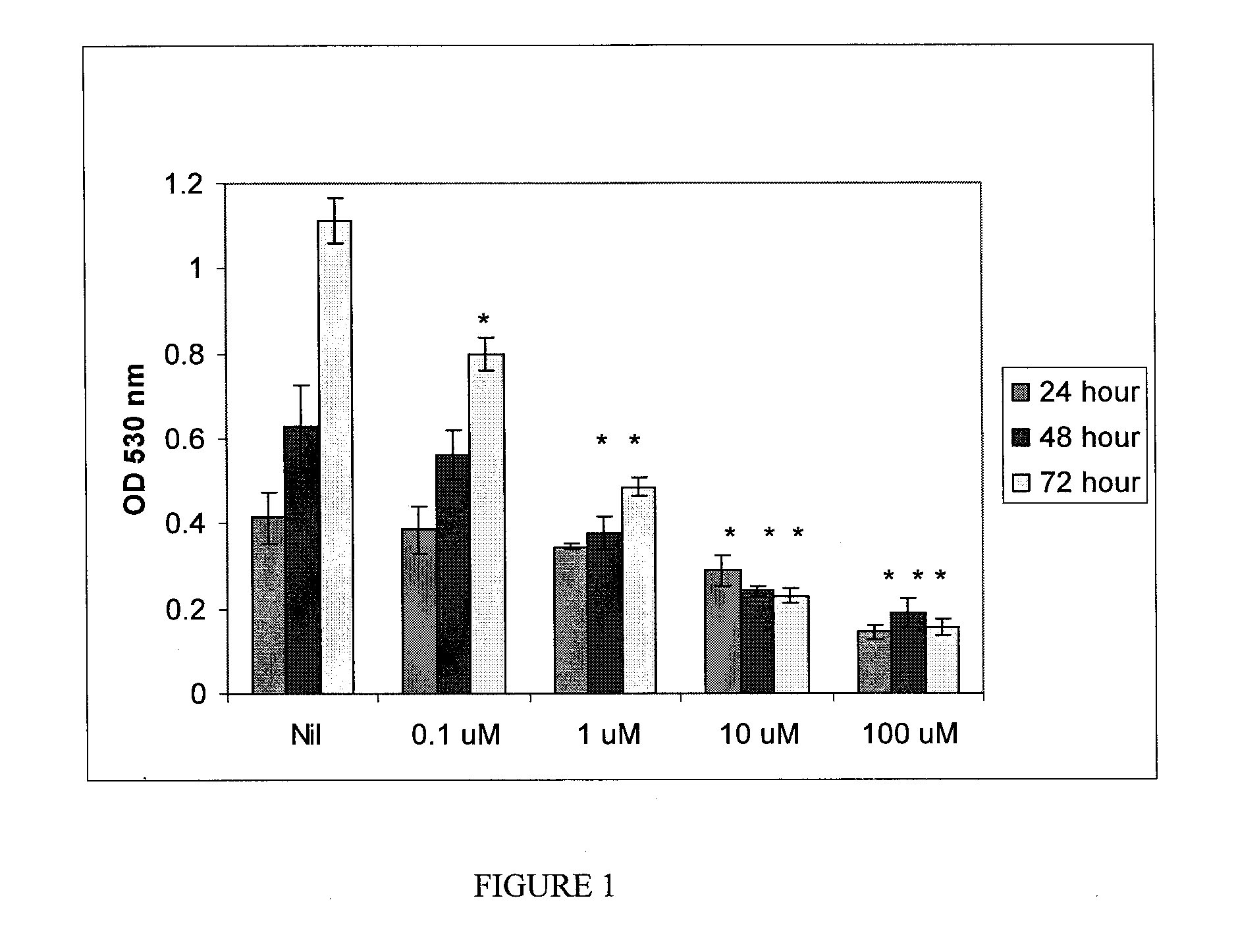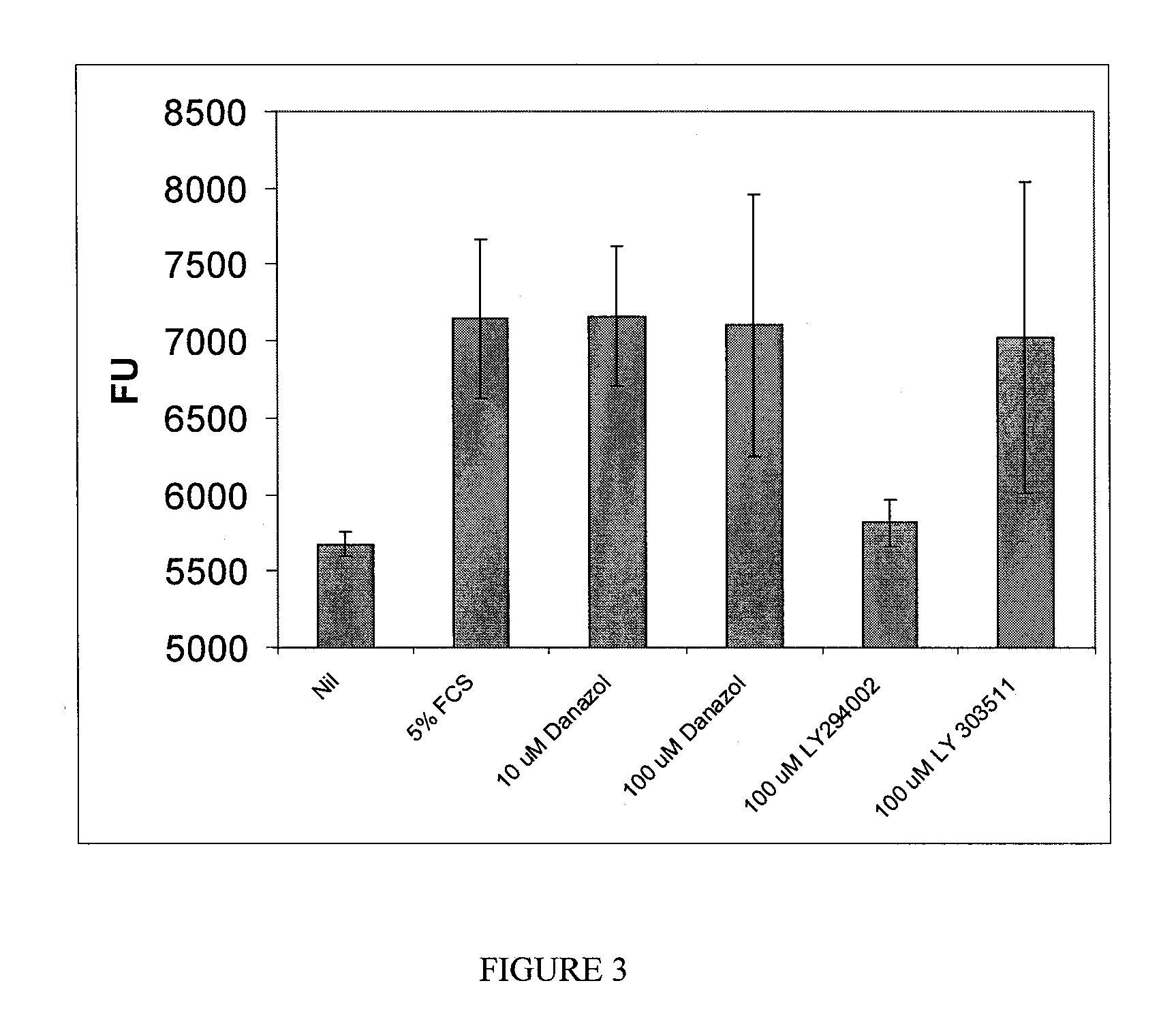Method for treatment of diseases
a disease and disease technology, applied in the field of diseases, can solve the problems of vascular leakage into underlying tissues, edema causing fluid leakage into tissues, and can have serious and life-threatening consequences, and achieve the effect of reducing the od obtained and no effect on cell proliferation
- Summary
- Abstract
- Description
- Claims
- Application Information
AI Technical Summary
Benefits of technology
Problems solved by technology
Method used
Image
Examples
example 1
Danazol's Effects on Angiogenesis (Comparative)
[0102]A. HUVEC Cell Proliferation
Protocol:
[0103]Primary human umbilical vein endothelial cells (HUVECs) and EGM-2 growth medium were obtained from Cambrex (Walkersville, Md.). The cells were passaged in medium supplemented with 2% fetal calf serum (FCS) in tissue culture flasks at 37° C. and 5% CO2. Subculturing was performed using trypsin when 60-80% confluence was obtained as specified by the supplier.
[0104]Cryopreserved ampoules of passage 2 HUVECs were thawed and plated in 96 well tissue culture plates at 5,000 cells / cm2. A 50 mM stock solution of danazol was prepared in ethanol and the FCS in the medium was increased to 5% to keep danazol in solution. The cells were treated with medium containing final concentrations of danazol ranging from 0.1 to 100 μM in triplicates. 24, 48, and 72 hour incubations were performed and cell proliferation was determined utilizing Celltiter 96 AQueous One Solution Cell Proliferation assay from Prome...
example 2
Danazol Effect on Vascular Permeability of HUVEC Monolayers
[0122]Protocol:
[0123]Assays were performed to determine the effect of danazol on permeability of HUVEC monolayers. Passage 5-10 HUVECs, lot number 7016 (obtained from Lonza), were seeded onto 1-micron-pore-size inserts located in the wells of a 24-well plate (Greiner BioOne 24-well Thincert cell culture inserts, #662610, or ISC BioExpress, #T-3300-15) using endothelial growth medium-2 (EGM-2) (obtained from Lonza). The plates were cultured in a 37° C. incubator with 5% CO2 for 48-72 hours to achieve confluence and develop tight monolayers. The medium was then removed and replaced with fresh medium or fresh medium containing a range of danazol concentrations (Sigma, #D8399). Tumor necrosis factor α (TNFα; Pierce Biotechnology, #RTNFAI) and interleukin-1β (IL-1β; Sigma, #I-9401) were added to appropriate wells at final concentrations of 10 ng / ml each. TNFα and IL-1β induce permeability; they can cause up to a ten-fold increase...
example 3
Danazol Effect on Vascular Permeability
[0127]Passage 9 human retinal endothelial cells (ACBR1181, Applied Cell Biology Research Institute, Kirkland, Wash.) were passaged in EGM-2 medium (Lonza, Walkersville, Md.) until 80% confluence was obtained. The cells were then released from the passage flask using Trypsin-EDTA, and the cells in the resulting suspension were counted to determine both viability and cell numbers. Viability of the cell suspension was greater than 90% in this experiment.
[0128]The cells were then seeded onto inserts (1 micron pore size) located in the wells of a 24-well plate (Greiner BioOne 24-well Thincert cell culture inserts, #662610) in 300 μl EGM-2 complete medium (obtained from Lonza). Then, 700 μl EGM-2 was placed in the bottom chamber, and the plates were cultured in a 37° C. incubator with 5% CO2 for 48 hours to achieve confluent monolayers. Transendothelial electrical resistance (TER) measurements were taken using an STX 100 electrode attached to EVOM2 v...
PUM
 Login to View More
Login to View More Abstract
Description
Claims
Application Information
 Login to View More
Login to View More - R&D
- Intellectual Property
- Life Sciences
- Materials
- Tech Scout
- Unparalleled Data Quality
- Higher Quality Content
- 60% Fewer Hallucinations
Browse by: Latest US Patents, China's latest patents, Technical Efficacy Thesaurus, Application Domain, Technology Topic, Popular Technical Reports.
© 2025 PatSnap. All rights reserved.Legal|Privacy policy|Modern Slavery Act Transparency Statement|Sitemap|About US| Contact US: help@patsnap.com



